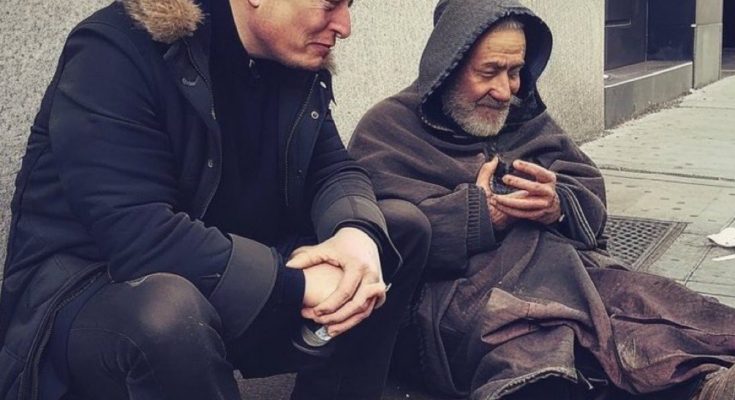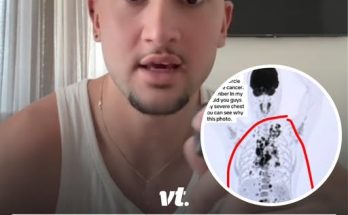The biting December wind swept through the streets of San Francisco, as Tom Wilson, a 73-year-old veteran, pulled his threadbare jacket tighter around himself. The past five years had been unforgiving. Once a mechanic in the Army and a proud family man, Tom’s life unraveled when his wife, Martha, fell ill with cancer.
The insurmountable medical bills drained their savings, and after her passing, Tom found himself on the streets. Still, he carried himself with quiet dignity, surviving day by day with his shopping cart of possessions and a cardboard sign that read: Veteran – Any Help Appreciated.

Tom’s usual spot was near the Tesla headquarters, where sleek cars and tech workers zipped past him without a glance. He didn’t hold it against them; invisibility was part of being homeless. But one morning, as he shuffled through his routine, organizing his few belongings, an unusual sight caught his attention – a sleek black Tesla sat smoking on the curb, its hood popped open.
The driver, visibly frustrated, paced back and forth, phone in hand. Even from a distance, Tom recognized him. It was Elon Musk, the billionaire tech mogul. For a moment, Tom hesitated. Approaching people – especially someone as prominent as Musk – could invite rejection or suspicion. But his instincts as a mechanic kicked in.
“Excuse me, sir,” Tom said softly as he neared the car. “Looks like you’ve got some trouble there. I used to be a mechanic in the Army. Maybe I could take a look?”
Musk paused, a flicker of hesitation in his eyes. But there was something genuine in Tom’s demeanor. “Sure,” Musk replied, stepping aside. “If you think you can help, I’d appreciate it. I’m running late for a meeting, and my phone’s not getting any signal here.”
Tom leaned over the engine, the familiar scent of oil and metal stirring memories of younger days. Despite his arthritic hands, his knowledge remained sharp. “Your cooling system’s got a leak,” Tom explained after a quick inspection. “I can patch it up temporarily, but you’ll need a proper fix later.”
Using supplies from his cart – a piece of rubber he’d saved, some duct tape, and even his drinking water – Tom worked methodically. Within 20 minutes, the engine roared to life.
Elon Musk’s face lit up with surprise. “That’s impressive,” he said, checking his watch. “You just saved me from missing an important meeting. How much do I owe you?”
Tom shook his head, stepping back. “Nothing, sir. Just happy to help. My father always told me helping others is its own reward.”
Musk studied the older man – his worn clothes, his shopping cart – then extended a business card. “Tom, right? Come to this address tomorrow morning at 9:00 a.m. Ask for Sarah in HR.”
Tom’s brow furrowed. “I don’t want charity.”
“It’s not charity,” Musk insisted. “It’s an opportunity. You’ve earned it.”
That night, Tom barely slept, the card clenched in his hand. The next morning, he cleaned up as best he could at a public restroom and arrived at the Tesla headquarters promptly at 9 a.m. The modern building’s sleek surfaces and bustling professionals made him feel out of place, but he pressed on.
To his surprise, he was escorted to a warm, welcoming woman named Sarah.
“Mr. Musk told us about you,” she said with a smile. “We’d like to offer you a position as a senior maintenance advisor. Your decades of mechanical experience could help us improve the repairability of our vehicles. We’ll also provide temporary housing and medical benefits.”
Tom’s hands trembled as he clutched the chair’s armrests. “Ma’am, I’m 73. Most people think I’m too old to work.”
Sarah’s smile deepened. “Mr. Musk believes wisdom and experience never expire. And he was impressed by your integrity—you helped without expecting anything in return. That’s the kind of person we want on our team.”
Later that day, Tom moved into a small but comfortable studio apartment provided by the company. On the table, he found a note and a check. The note read: “Tom, your kindness reminded me of what really matters. Use this to pay off your wife’s medical bills and start fresh. -Elon.”
Tom sank to his knees, overwhelmed by gratitude. For the first time in years, he cried—not from despair, but from hope.
Tom’s role at Tesla was a natural fit. His hands-on knowledge bridged the gap between traditional mechanics and cutting-edge EV technology. His practical advice helped engineers design vehicles that were easier to repair, benefiting both Tesla and everyday mechanics.
But Tom’s influence extended beyond the technical. His humility and generosity inspired his colleagues. He became known for carrying granola bars to hand out to homeless people he passed on his way to work. “Sometimes, kindness is all it takes to change a life,” he’d say with a gentle smile. “I should know.”
Word of Tom’s story spread throughout the company, sparking a cultural shift. Employees began volunteering at shelters, and Tesla launched a program to hire veterans and older workers who had faced hard times. Musk himself highlighted Tom’s story in interviews, calling it a testament to resilience and the power of compassion.
A year later, on the anniversary of the day he met Musk, Tom returned to his old spot near Tesla headquarters. But this time, instead of a cardboard sign, he brought sandwiches and warm blankets for those still struggling. He sat and talked with them, sharing his story as proof that life could change in an instant.
Tom’s journey became a beacon of hope, showing that even in the darkest moments, kindness could create ripples of change. His life was a testament to the belief that no matter how dire the circumstances, it’s never too late for a second chance.
And, as he often told others, “Helping someone else might just end up helping you, too.”



